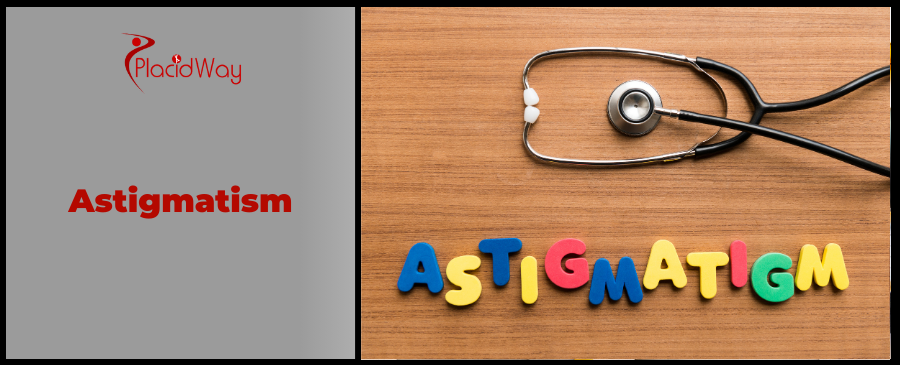
Regain Crisp Vision: Your Guide to Astigmatism Treatment & Medical Tourism
Are you experiencing blurry vision, headaches, or difficulty seeing clearly at night? These could be signs of astigmatism, a common vision condition that affects millions worldwide. Astigmatism occurs when your cornea (the front surface of your eye) or lens, inside your eye, has an irregular curve. Instead of being perfectly round like a basketball, it might be shaped more like a football, causing light to focus unevenly on your retina. This results in distorted or blurred vision at all distances.
The good news is that astigmatism is highly treatable. While glasses or contact lenses can provide temporary correction, many people are exploring permanent solutions through advanced refractive surgeries like LASIK, PRK, or SMILE. These procedures reshape the cornea to correct its curvature, allowing light to focus properly and restoring crisp, clear vision.
For those seeking high-quality care without the high costs or long wait times often found at home, medical tourism offers an attractive alternative. Patients from countries like the USA, Canada, and the UK are increasingly traveling to destinations known for their excellent ophthalmology clinics, experienced surgeons, and significantly more affordable prices for astigmatism correction. This comprehensive guide will walk you through everything you need to know about astigmatism, its treatments, and how medical tourism can make clear vision a reality for you.
What are the common symptoms of astigmatism?
Recognizing the signs of astigmatism is the first step toward getting the help you need. Many people don't realize they have it until they experience persistent visual discomfort or notice a decline in their vision quality. Common symptoms include:
- Blurred or Distorted Vision: This is the hallmark symptom, affecting objects both near and far. Straight lines might appear wavy, and objects can look stretched or fuzzy.
- Eye Strain or Discomfort: Your eyes work harder to compensate for the irregular focus, leading to fatigue, aching, or a burning sensation.
- Headaches: Often a direct result of prolonged eye strain from trying to focus.
- Squinting: Instinctively, people with astigmatism often squint to try and sharpen their vision.
- Difficulty with Night Vision: Lights can appear to have halos, starbursts, or excessive glare, making driving at night particularly challenging and uncomfortable.
If these symptoms sound familiar, it's crucial to consult an eye care professional for a comprehensive eye exam. Early diagnosis ensures you get the right corrective measures, whether through glasses, contacts, or surgery.
What causes astigmatism and who is at risk?
Understanding the root cause of astigmatism can help clarify why treatment is necessary. Essentially, astigmatism is a refractive error, meaning the eye doesn't bend light correctly. This usually happens for one of two reasons:
- Corneal Astigmatism: The most common type, where the cornea (the clear front dome of your eye) is unevenly curved. Instead of being perfectly round, it's shaped more like a football.
- Lenticular Astigmatism: Less common, this occurs when the lens inside your eye has an irregular shape.
For most people, astigmatism is present from birth, often hereditary, meaning it runs in families. It's not usually caused by reading in dim light or sitting too close to the TV! While it's largely genetic, certain factors can increase your risk or contribute to its development later in life:
- Family History: If your parents or siblings have astigmatism, you're more likely to develop it.
- Eye Injury or Disease: Trauma to the eye or certain eye diseases (like keratoconus, a condition where the cornea progressively thins and bulges into a cone shape) can cause or worsen astigmatism.
- Previous Eye Surgery: Some types of eye surgery, such as cataract surgery, can sometimes induce or change astigmatism.
It's important to note that astigmatism is not an eye disease but a common variation in eye shape. It can, however, significantly impact your quality of life if left uncorrected.
What are the effective treatment options for astigmatism?
Correcting astigmatism means helping your eyes focus light properly. There are several ways to achieve this, from simple optical aids to advanced surgical procedures:
- Corrective Lenses:
- Glasses: The easiest and most common way to correct astigmatism. Lenses are specifically designed to compensate for the irregular curvature of your eye.
- Contact Lenses: Toric contact lenses are specifically designed for astigmatism, with different powers in different parts of the lens to correct the uneven curvature.
- Refractive Surgery: These procedures offer a more permanent solution by reshaping the cornea.
- LASIK (Laser-Assisted In Situ Keratomileusis): The most popular laser eye surgery. A thin flap is created on the cornea, lifted, and a laser reshapes the underlying corneal tissue. The flap is then repositioned. Recovery is typically fast.
- PRK (Photorefractive Keratectomy): An alternative to LASIK, especially for those with thinner corneas or who participate in contact sports. No flap is created; instead, the outer layer of the cornea (epithelium) is removed, and the laser reshapes the underlying tissue. The epithelium then grows back. Recovery takes a bit longer than LASIK.
- SMILE (Small Incision Lenticule Extraction): A newer, minimally invasive laser procedure. A small, lens-shaped piece of tissue (lenticule) is created inside the cornea with a laser and then removed through a tiny incision, reshaping the cornea.
- ICL (Implantable Collamer Lens): For individuals who are not candidates for LASIK or PRK due to high prescriptions or thin corneas, an ICL is a permanent lens surgically implanted inside the eye without removing the natural lens.
For those considering a permanent solution and exploring options abroad, refractive surgeries like LASIK, PRK, and SMILE are the most frequently sought-after treatments.
Who is a good candidate for astigmatism correction surgery?
While refractive surgery offers incredible benefits, it's not suitable for everyone. A thorough evaluation by an ophthalmologist is essential to determine your candidacy. Generally, good candidates for astigmatism correction surgery:
- Are at Least 18 Years Old (often 21+): Your eyes and prescription should be stable, which usually happens by this age.
- Have a Stable Prescription: Your astigmatism prescription should not have changed significantly for at least one to two years prior to surgery.
- Have Healthy Eyes: You shouldn't have any active eye diseases (like glaucoma, cataracts, or severe dry eye), infections, or injuries that could interfere with healing or outcomes.
- Have Adequate Corneal Thickness: This is crucial for LASIK and PRK, as sufficient tissue must remain after reshaping.
- Are Not Pregnant or Breastfeeding: Hormonal fluctuations can affect vision and healing.
- Have Realistic Expectations: While outcomes are excellent, it's important to understand the potential risks and limitations of the procedure.
A comprehensive eye exam, including corneal topography and pachymetry (corneal thickness measurement), will be performed to assess your suitability for surgery. Clinics abroad maintain these same rigorous screening standards to ensure patient safety and optimal results.
What is the recovery time like after astigmatism correction surgery?
One of the appealing aspects of modern astigmatism correction surgery is the relatively fast recovery period, especially for procedures like LASIK. However, recovery can vary depending on the specific type of surgery and individual healing rates. Here's a general overview:
- Immediately After Surgery: You might experience mild discomfort, a gritty sensation, light sensitivity, and watery eyes. Vision will be hazy but usually improved from before surgery. You'll typically need to wear protective eye shields.
- First 24-48 Hours (LASIK): Many patients experience a dramatic improvement in vision within hours. Most can return to light activities and even work within a day or two.
- First Few Days to Week (PRK): Recovery is slower for PRK as the surface layer of the cornea needs to regenerate. You'll likely wear a bandage contact lens for several days. Vision gradually improves over the first week, and you might need more time off work.
- First Few Weeks: Your vision will continue to stabilize. You'll use prescribed eye drops to prevent infection and aid healing. Mild dryness, halos, and glare at night are common but usually temporary.
- Full Stabilization: It can take anywhere from one to six months for your vision to fully stabilize and for any minor side effects like dry eyes or night vision issues to resolve completely.
During your recovery, it's crucial to follow your surgeon's post-operative instructions carefully, including using eye drops, avoiding rubbing your eyes, and refraining from swimming or strenuous activities for a specified period. When traveling abroad, clinics ensure clear post-op instructions are provided, often with translator support, and schedule necessary follow-up checks before your return home.
What are the potential risks and side effects of astigmatism surgery?
Like any medical procedure, astigmatism correction surgery comes with potential risks and side effects, though serious complications are rare. It's important to discuss these thoroughly with your surgeon before making a decision. Common temporary side effects and potential risks include:
- Dry Eyes: This is the most common side effect and can last for several weeks or months. It's usually managed with lubricating eye drops.
- Visual Disturbances: Halos (rings around lights), glare, and starbursts, especially at night, are common initially but often diminish over time.
- Under- or Overcorrection: Sometimes, the laser treatment might not perfectly correct the astigmatism, resulting in residual refractive error. This might require glasses, contacts, or a "touch-up" enhancement surgery.
- Flap Complications (LASIK): Though rare with modern techniques, issues with the corneal flap (e.g., irregular flap, displacement) can occur.
- Infection or Inflammation: As with any surgery, there's a small risk of infection, managed with antibiotics.
- Regression: In some cases, vision can gradually return to being slightly blurry over several years, potentially requiring a follow-up procedure.
- Rare but Serious Complications: Extremely rare risks include significant vision loss or ectasia (weakening and bulging of the cornea).
Choosing an experienced surgeon and a reputable clinic, whether at home or abroad, significantly minimizes these risks. Thorough pre-operative screening also helps identify individuals who might be at higher risk for certain complications.
How much does astigmatism treatment cost worldwide?
Cost is a major factor for many considering astigmatism correction. Refractive surgeries are often deemed elective and may not be covered by standard health insurance in Western countries, making the price tag substantial. This is where medical tourism shines, offering significant savings without compromising on quality.
Here's an estimated cost comparison for common astigmatism correction procedures (like LASIK/PRK) per eye, globally:
| Country | Estimated Cost Per Eye (USD) | Notes |
|---|---|---|
| USA | $2,000 - $4,000+ | High-end technology, experienced surgeons, but often not covered by insurance. |
| Canada | $1,800 - $3,500+ | Similar to USA, may have some regional variations. |
| UK | £1,500 - £3,000 (~$1,900 - $3,800) | Private clinics offer high standards. |
| Turkey | $700 - $1,500 | Very popular for eye surgery, excellent facilities, highly competitive prices. |
| Mexico | $800 - $1,800 | Convenient for North American patients, growing medical tourism hub. |
| India | $500 - $1,200 | World-class doctors and hospitals at significantly lower costs. |
| Thailand | $900 - $1,800 | Known for high-quality care and a pleasant recovery environment. |
These figures are estimates and can vary based on the clinic, the specific procedure (LASIK, PRK, SMILE, ICL), the surgeon's experience, and any package inclusions (e.g., accommodation, transfers). However, the trend is clear: significant savings can be achieved by looking beyond your home country.
Why consider astigmatism correction abroad?
The decision to travel for medical treatment, especially for something as crucial as your eyesight, is significant. However, for many, the advantages of seeking astigmatism correction abroad far outweigh staying local:
- Significant Cost Savings: As seen in the table above, the primary driver for medical tourism is often the dramatic reduction in cost, often 50-70% less than in Western countries, without compromising quality.
- Access to Advanced Technology & Expert Surgeons: Many international clinics invest heavily in the latest laser technology and boast highly experienced, internationally trained ophthalmologists, often performing a higher volume of procedures.
- Reduced Waiting Times: In countries with public healthcare systems, elective procedures like astigmatism correction can have long waitlists. Going abroad means faster access to treatment.
- Comprehensive Packages: Many medical tourism providers and clinics offer all-inclusive packages that cover not only the surgery but also accommodation, airport transfers, and even follow-up care, simplifying the process.
- Privacy and Anonymity: Some patients appreciate the discretion of having their procedure done away from their home community.
- "Med-Holiday" Opportunity: Combine your medical procedure with a vacation. Recover in a beautiful, relaxing environment, turning a medical necessity into a refreshing experience.
For individuals seeking both exceptional care and financial prudence, medical tourism for astigmatism correction presents a compelling solution, offering clear vision and potentially life-changing experiences.
Which countries offer the best value for astigmatism surgery?
When searching for "affordable astigmatism surgery" or "best countries for eye surgery," certain destinations consistently rise to the top due to their combination of quality, experience, and cost-effectiveness:
- Turkey: Particularly Istanbul, is a global leader in eye surgery. Clinics are highly accredited, often by international bodies, and feature cutting-edge technology. The high volume of procedures means surgeons gain extensive experience.
- Mexico: Especially cities near the US border or popular tourist destinations like Cancun and Tijuana, offers convenient access for North American patients. High-quality clinics provide excellent care at a fraction of US prices.
- India: Renowned for its advanced medical infrastructure and highly qualified, English-speaking doctors. India provides some of the most competitive prices globally for all types of eye surgeries, often without compromising on technology or care standards.
- Thailand: Known for its luxurious hospitals and excellent patient care, Thailand offers a blend of top-tier medical services with a recovering-vacation experience. Bangkok and Phuket are popular medical tourism hubs.
- South Korea: While slightly higher in cost than some other Asian destinations, South Korea is at the forefront of medical technology and innovation, particularly in cosmetic and refractive surgeries. Patients seeking the very latest techniques often look here.
When selecting a country, it's vital to research individual clinics, surgeon credentials, patient reviews, and international accreditations to ensure you're receiving safe and high-quality care.
What should I expect when traveling for astigmatism treatment abroad?
Embarking on a medical journey abroad might seem daunting, but reputable medical tourism facilitators and clinics simplify the process significantly. Here's what you can generally expect:
- Initial Consultation & Planning:
- Remote Assessment: Many clinics offer virtual consultations where you submit your eye exam results and medical history to determine initial suitability and receive a personalized quote.
- Logistics Assistance: Medical tourism agencies like PlacidWay can help with flight bookings, accommodation near the clinic, and airport transfers.
- Arrival & Pre-Operative Care:
- Comprehensive Eye Exam: Upon arrival, you'll undergo a detailed eye examination and diagnostic tests (e.g., corneal topography) to confirm your candidacy and plan the exact surgical approach.
- Consultation with Surgeon: You'll meet your surgeon to discuss the procedure, risks, and expected outcomes, ensuring all your questions are answered.
- The Procedure Day:
- The surgery itself is typically quick, often taking only 15-30 minutes for both eyes.
- You'll receive post-operative instructions, eye drops, and protective eyewear.
- Post-Operative Recovery & Follow-ups:
- You'll need at least one to two follow-up appointments in the days immediately following surgery to monitor healing and vision progress. Most patients stay for 5-7 days after surgery.
- Take it easy during this time, avoiding strenuous activities and following all post-op care instructions.
- Return Home & Continued Care:
- Your surgeon will provide clear instructions for at-home care and suggest a local eye doctor for ongoing follow-up.
- Many clinics offer remote support or teleconsultations for any concerns post-return.
Throughout your journey, many clinics provide English-speaking staff or dedicated translators to ensure clear communication and a comfortable experience.
How can I ensure safety and quality when choosing a clinic abroad?
Ensuring the safety and quality of your astigmatism treatment abroad is paramount. While many international clinics meet or exceed Western standards, due diligence is key. Here’s how you can make an informed choice:
- Check for International Accreditations: Look for clinics accredited by organizations like Joint Commission International (JCI), the International Society of Refractive Surgery (ISRS), or other recognized international healthcare quality bodies. These accreditations signify adherence to strict quality and patient safety standards.
- Verify Surgeon Credentials and Experience: Research your surgeon's qualifications, board certifications, and the number of astigmatism correction procedures they have performed. Many top surgeons abroad have international training and memberships in prestigious ophthalmological societies.
- Review Patient Testimonials and Before/After Photos: Genuine patient reviews on independent platforms and verifiable success stories can provide valuable insights into a clinic's patient experience and surgical outcomes.
- Inquire About Technology and Facilities: Ensure the clinic uses state-of-the-art diagnostic equipment and the latest laser technology (e.g., femtosecond lasers for LASIK flap creation). Modern equipment indicates a commitment to advanced, safe procedures.
- Ask About Post-Operative Care: Understand what follow-up care is provided both at the clinic and how they support you once you return home.
- Use a Reputable Medical Tourism Facilitator: Companies like PlacidWay specialize in vetting clinics and connecting patients with trusted, high-quality providers abroad. They can streamline the process and offer an extra layer of assurance.
By taking these steps, you can confidently choose a clinic abroad that offers not just affordability, but also the peace of mind that comes with high-quality, safe medical care.
Take the Next Step with PlacidWay
Ready to explore treatment options abroad? Discover top clinics, compare prices, and get a free quote tailored to your needs with PlacidWay.
Laser Eye Surgery, LASIK Eye Surgery Abroad










Share this listing